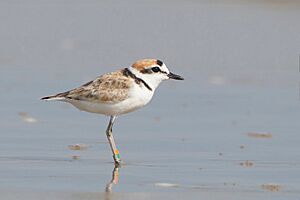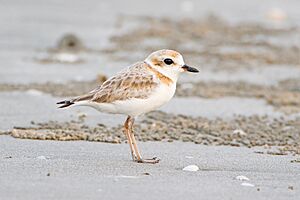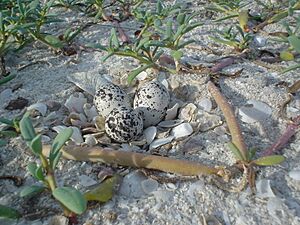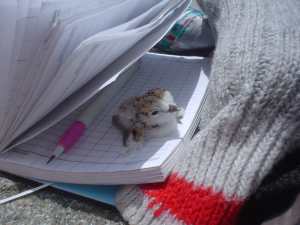Malaysian plover facts for kids
Quick facts for kids Malaysian plover |
|
|---|---|
 |
|
| male | |
 |
|
| female | |
| Conservation status | |
| Scientific classification |
The Malaysian plover (Anarhynchus peronii) is a small wader bird. It weighs about 35–42 grams. These birds build their nests on beaches and salt flats in Southeast Asia.
What Does the Malaysian Plover Look Like?
The Malaysian plover is about 15 cm (5.9 in) long. You can tell the males and females apart. Males have a thin black band around their neck. Females have a thin brown band instead. Their legs are a pale color. When they make a sound, it's a soft twit.
Life Cycle and Reproduction
Malaysian plovers lay two to five eggs. Most often, they lay three eggs. These eggs are hard to see because they blend in with the sand. They lay their eggs in small scrapes on beaches.
Both the male and female plover take turns sitting on the eggs. This is called incubation. It takes about 30 days for the eggs to hatch. After the chicks hatch, both parents care for them. The chicks are precocial, meaning they can move around soon after hatching. They stay with their parents until they can fly, which takes about 30 more days.
In Thailand, these birds might lay eggs more than once. This happens if their first set of eggs hatches successfully. They might also lay more eggs if their first attempt fails. The breeding season starts in late March and can last until September. Malaysian plovers find their food, like small invertebrates, on beaches and mudflats.
Why Are Malaysian Plovers Near-Threatened?
The Malaysian plover is considered a near-threatened species. This means it could become endangered soon. There are about 10,000 of these birds left. Their numbers are going down. This is mainly because of new buildings and too many people disturbing their homes.
When people use beaches more, they might accidentally step on eggs or chicks. Also, adult birds might leave their nests if there are too many people around. This leaves the eggs and chicks open to heat from the sun.
A study in the Gulf of Thailand looked at how changes to the land affect these birds. It found that turning short, bushy plants into tall Casuarina forests is a problem. Also, building sea walls stops chicks from moving freely. Chicks need to go between feeding areas on the mudflat and safe hiding spots in the plants behind the beaches. These changes make it harder for the plovers to find good places to live.
Sandy tropical beaches are very valuable. Because of this, many new buildings are being put up. This puts pressure on the remaining places where Malaysian plovers live in Thailand. As the economy grows, more people visit these beaches. This means more disturbance for the birds.
Some important places for Malaysian plovers in Thailand include Khao Sam Roi Yot National Park. This is Thailand's first protected marine area. Other key areas are beaches near Bonok village in Prachuap Khiri Khan province. Also, Laem Phak Bia in Petchburi province is important. People are working to protect these special beaches. For example, a seawall built in 2005 in Laem Phak Bia changed the bird's habitat a lot.
A study from 2006 looked at how tourism affects these birds. Researchers studied many adult plovers and chicks in Thailand. They found that tourism development on beaches causes problems. It can lead to beach erosion. It also changes the types of plants on the beach. And it increases human disturbance. All these things mean fewer chicks survive and the birds have less good habitat.




